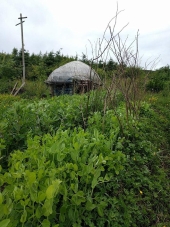


Nancy Reading wrote:The simple three field rotation of grains, followed by legumes, followed by fallow (animal grazing) was pretty standard in much of Europe in the medieval period I understand. I find it difficult to believe though, that people stuck loads of pea stick in the fields for their peas and beans to grow on and then took them off again the following year - it just sounds like rather too much work on a field sized system!
How did they manage it? I experimented this year with not supporting most of my peas. I interplanted some with my fava beans and some were just by themselves, but (as you might expect!) the results were less than satisfactory - the pea vines scrambled over the ground, and the slugs and mice had most of the peas produced (despite a good growing year for me generally). I don't think shorter peas (which are one obvious solution) were available till about the 19th century this article has some background reading on peas...) so that wouldn't be the medieval solution.
So my questions are - did they use pea sticks or another method? What do you think might work with less labour on a larger scale?

Xisca Nicolas wrote:Thanks for feedback and sharing! So basically you used 15 times more surface to cut than the one you covered?
When you did this, did you find it was "no work"? just joking.... well, "less weeding" method is right! Or "no dig".

Xisca Nicolas wrote:If I want to use this method and not work after 11 am, I have to figure out how to solve a few ..."difficulties"!
- I cannot find hay, maybe straw imported from mainland Spain... (not organic, so full of round up?)
- Whatever natural hay we still have (wild oats grow in winter) goes to the animals.
So, unless you rely on a truck and live in a place with hay ...who can answer THIS question:
"What is the surface of land you need, planted with grass, for what surface of garden you grow?"
or put it this way:
"Out of your garden, what % do you have to dedicate to mulch production?"
Bryant RedHawk wrote:download the book
scribd site download of the book
There you go.
Redhawk
Most book stores will order in books for you, many public libraries will have those two books too.